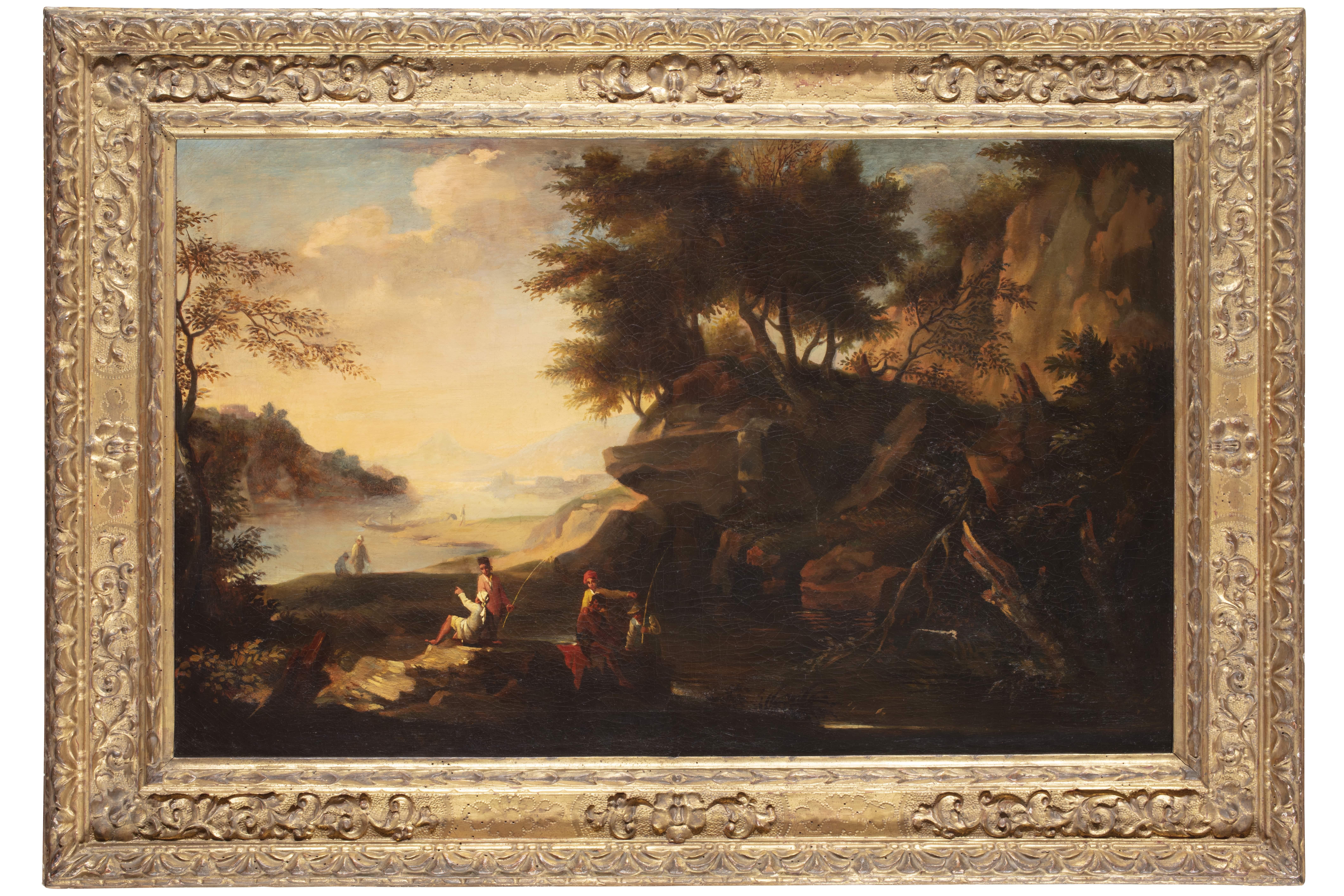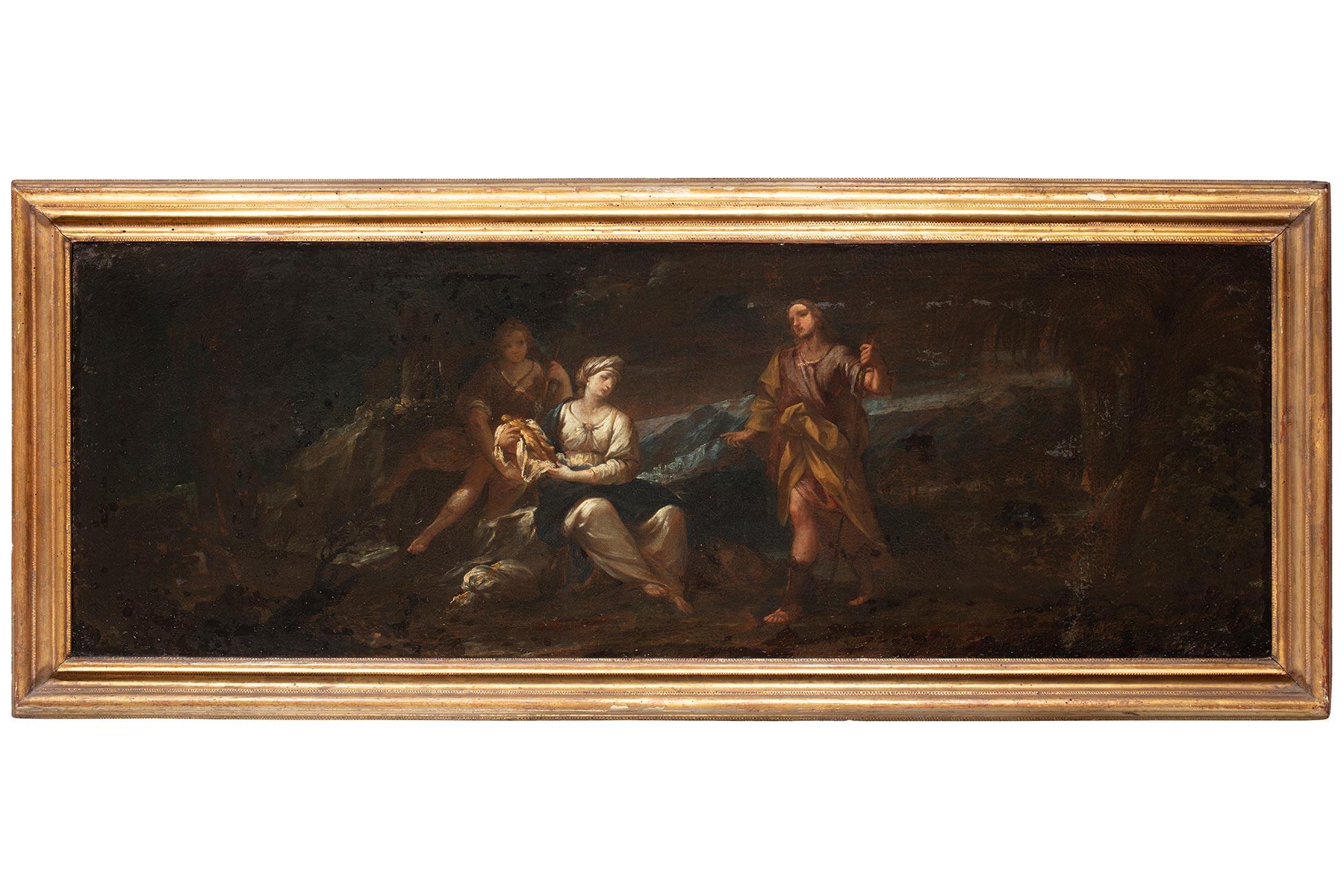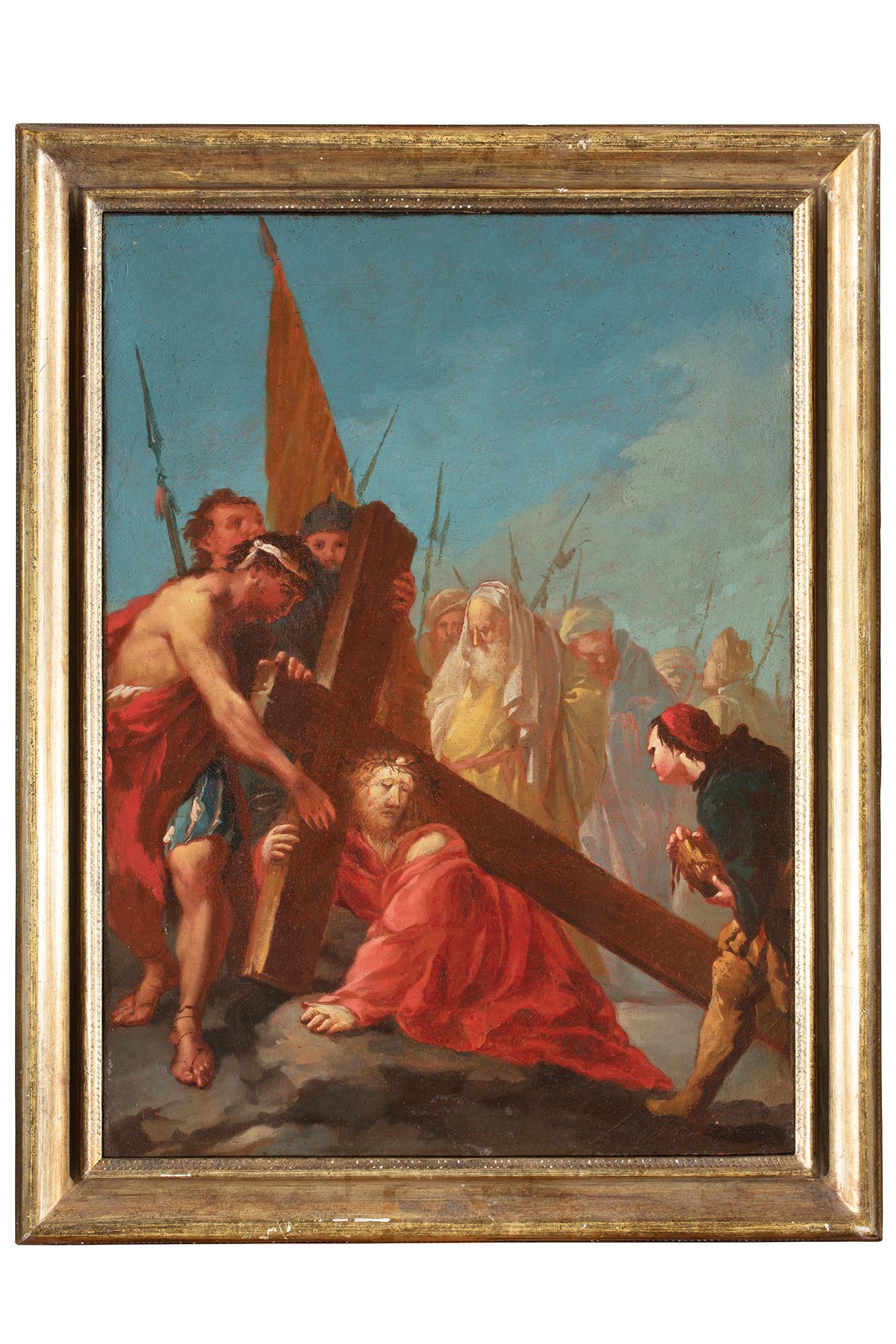Items Similar to View of the Grand Canal, a painting by William James, after Canaletto
Want more images or videos?
Request additional images or videos from the seller
1 of 14
William JamesView of the Grand Canal, a painting by William James, after Canaletto
About the Item
Although we have little bibliographical information on William James, we know that he was trained by Canaletto during the painter's stay in England between 1746 and 1755. Although he may never have been to Venice, William James remained under the influence of his master for a long time and became known for his paintings inspired by Canaletto's artworks.
In this painting, William James is inspired by one of the twelve views of the Grand Canal painted by Canaletto for Joseph Smith, or more precisely by the engraving made by Antonio Visentini in 1735 after this painting. He delivers a very personal version, vibrant with colours, in which he brilliantly reproduces the moving surface of the sea, animated by the ever-changing traffic of the gondolas.
1. William James, the English follower of Canaletto
The life of William James, who worked as a vedutist between 1754 and 1771, remains largely an enigma. While we have no precise biographical data, Edward Edwards reports in his Anecdotes of Painters (published in 1808) that James was a pupil or an assistant of Antonio Canal, known as Canaletto (1697 - 1778) during his stay in England between 1746 and 1755. This collaboration had a decisive influence on the work of William James, who later largely imitated Canaletto's Venetian views, which were so fashionable at the time, but also the London paintings of Samuel Scott. James lived for some years in Maiden Lane, Covent Garden, and then at the Golden Head in May's Buildings, St Martin's Lane, an area of London popular with artists and craftsmen.
James exhibited at the Society of Artists of Great Britain from 1761 to 1768 and at the Royal Academy from 1769 to 1771. He became a member of the Society of Artists in 1766. Most of the paintings he exhibited were views of London, but he also produced a series of Egyptian temples which he exhibited at the Society of Artists in 1768 and at the Royal Academy between 1769 and 1771 (where he also exhibited a View of the Grand Canal in Venice in 1771).
It is thought that James never left England, so these Egyptian images must have been based on the sketches of an unknown traveller. As for his views of Venice, which are the most sought-after part of his work, he was mainly inspired, as we shall see in more detail, by Antonio Visentini's Prospectus Magni Canalis Venetiarum, a collection of engravings based on Canaletto's paintings.
2. From Canaletto's painting to Visentini's engraving
In 1727 Canaletto painted a View of the Grand Canal to the West, from the Vendramin-Calergi Palace in San Geremia (10th picture of the Gallery). This view was acquired with the entire Joseph Smith’s collection by King George III in 1762 and is now part of the Royal Collection. This view is part of a set of twelve paintings commissioned from Canaletto by Joseph Smith, an Englishman based in Venice who had become Canaletto's dealer.
This set was probably made between 1722 and 1732; two festival scenes painted between 1733 and 1734 were added to this set. These fourteen scenes were then engraved by Antonio Visentini and published under the title Prospectus Magni Canalis Venetiarum by Pasquali in 1735. It should be noted that they were engraved in reverse and that the engravings therefore appear in the same direction as the original paintings.
On the right, Canaletto depicts the imposing Renaissance façade of Palazzo Vendramin-Calergi, commissioned in 1481 from Mauro Codussi. Canaletto mistakenly added a balustrade to the second floor and depicted two arched windows on either side of the doorway opening onto the canal - there should only be one on each side, flanked by a rectangular window (Canaletto had drawn the palace correctly in his sketchbook). In the distance is the tower of San Geremia, correctly proportioned but perhaps slightly off to the right. Canaletto has shown three openings instead of two on each side of the bell tower. The windows of the adjacent church are also very inaccurately depicted.
To the left, in the shadows, are the Ca' Tron and the Palazzo Belloni-Battagia. Beyond we see the brick facade of the fifteenth-century granaries, the Deposito del Megio, followed by the Fondaco dei Turchi, built in the thirteenth century as an office and used as warehouse for Turkish merchants between 1621 and 1838. The Deposito is normally set back from Palazzo Belloni-Battagia, as the canal curves to the left at this point. Canaletto has flattened and straightened the left bank of the canal to show the Deposito and the Fondaco, which would normally be half hidden, and the two sunlit buildings at the back, which would not be visible at all.
We have reproduced above the engraving by Visentini in which he corrected the inaccuracies introduced by Canaletto, particularly in the façade of Palazzo Vendramin-Calergi (last photo of the Gallery).
3. The originality of William James' painting
It is quite possible that William James saw Canaletto's painting in London after it was bought by George III, but it seems certain that his first source of inspiration was Visentini's engraving. The treatment of the façade of the Vendramin-Calergi palace (to the right of the canal) is based upon Visentini's engraving, and therefore does not include the changes introduced by Canaletto. The Tower of San Geremia is also shown with its two openings on each side.
While William James remains faithful to Visentini, and thus to Canaletto's original model, in the general arrangement of the various buildings, the chromatic range takes us away from the Venetian model, towards an explosion of enchanting colors. The orange-red colors of the palaces (inspired by those of English facades) stand out clearly in the cooler light, evoking the atmosphere of the banks of the Thames, which James also depicted on many occasions.
This freedom in the choice of colors confirms the hypothesis that James was mainly inspired by Visentini's engraving, which he had the delicate task of transcribing into color.
While the architectural setting is faithfully reproduced, the painting is enlivened by numerous innovations in the positioning of the characters and by the gondola traffic that animates the canal. Whereas Canaletto had two large red hangings on either side of the canal, James, perhaps inspired by festival scenes, introduces numerous colorful hangings that enliven the windows of the palaces, both on the right and left sides of the canal.
The position of the gondolas is also quite different: James is pushing them higher up in the composition, clearing the moving space of the canal. We can almost perceive the light sea breeze blowing across the quivering waters, in which the sky and the façades of the palaces are reflected, as well as the numerous gondolas whose passengers are finely depicted.
4. Framing
This vivid painting is presented in a gilded wooden frame in the neo-classical style.
Main bibliographic reference :
Rozie Razzal & Lucie Whitaker - Canaletto & the Art of Venice - Royal Collection Trust London 2017
- Creator:William James (1882 - 1961, American)
- Dimensions:Height: 30.69 in (77.96 cm)Width: 45.69 in (116.06 cm)
- Medium:
- Movement & Style:
- Period:
- Condition:24 3/8” x 39 3/8” (62 x 100 cm) - framed 30 11/16” x 45 11/16” (78 x 116 cm) Provenance: Paris Private collection. This painting probably originally came from an English collection as indicated by the English label on the back of the frame.
- Gallery Location:PARIS, FR
- Reference Number:1stDibs: LU1568212305222
About the Seller
5.0
Vetted Seller
These experienced sellers undergo a comprehensive evaluation by our team of in-house experts.
Established in 2020
1stDibs seller since 2021
8 sales on 1stDibs
Typical response time: 2 hours
- ShippingRetrieving quote...Ships From: PARIS, France
- Return PolicyA return for this item may be initiated within 3 days of delivery.
More From This SellerView All
- The Arrival of the Storm, a painting by the school of Claude-Joseph VernetBy Claude-Joseph VernetLocated in PARIS, FRDuring his stay in Italy from 1734 to 1752, Joseph Vernet made several trips to Naples between 1737 and 1746, where he painted numerous maritime scenes. The pre...Category
1770s Old Masters Landscape Paintings
MaterialsOil, Canvas
- The Parade of Swiss Guards a painting on canvas by Gabriel de Saint-AubinLocated in PARIS, FRIn this painting, Gabriel de Saint-Aubin, the great chronicler of the reign of Louis XV, takes us to the annual parade of the Swiss Guards at the Plaine de...Category
1760s Old Masters Figurative Paintings
MaterialsCanvas, Oil
- Italian Landscape with Jack Players, a painting by Gaspard Dughet (1615 - 1675)By Gaspard DughetLocated in PARIS, FRHere Gaspard Dughet offers us an idyllic vision of the Roman countryside. The stages follow one another in a perfectly structured composition, revealing here a lake, there travellers walking along, gradually leading our eye to the blue horizon. But behind its classical composition, this landscape is particularly interesting because of three anthropomorphic details that the artist has hidden, opening the way to a radically different interpretation... 1. Gaspard Dughet, a landscape artist in the light of Poussin Gaspard Dughet was born on June 4th, 1615 in Rome where his father, of French origin, was a pastry cook. He was probably named Gaspard in honour of his godfather Baron Gaspard de Morant, who was, or may have been, his father's employer. His older sister Jeanne married the painter Nicolas Poussin (1594 - 1655) on September 1st, 1630. The young Gaspard was apprenticed with his brother-in-law at the beginning of 1631, which led his entourage to name him Gaspard Poussin. The first preserved works of the painter date from the years 1633-1634 and were painted in Poussin’s studio. Around 1635, Gaspard Dughet became emancipated and began to frequent the Bamboccianti circle. In 1636, he became friends with the painter Jean Miel (1599 - 1656), but also with Pier Francesco Mola (1612 - 1666) and Pietro da Cortona (1596 - 1669). This was also the time of his first trips throughout Italy. The painter, although of French origin, appears never to have visited France. In 1646 he settled permanently in Rome. A recognized painter with a solid book of orders, he remained faithful to landscape painting throughout his life, alternating between cabinet paintings and large decorative commissions, using both oil and fresco. Nailed to his bed by rheumatic fever at the age of 58, he died on May 25, 1675. 2. Discovering an idealized landscape Beyond a relatively dark foreground that takes us into the landscape, we discover a vast bluish horizon: a plateau surrounded by deep ravines advances to the right, overhanging an expanse of water that sparkles below. A road winds through a mountainous mass as if leading us to the fortress that crowns it; another town appears in the distance at the foot of three conical mountains. The composition is rigorous, mineral, and structured by geometric volumes. The various stages in the landscape lead one to the next attracting the eye towards the horizon located in the middle of the canvas. The general impression is that of a welcoming and serene nature. In many places the paint layer has shrunk, or become transparent, revealing the dark red preparation with which the canvas was covered and accentuating the contrasts. Human presence is limited to three jack players, leaning against a mound in the foreground. Their long garments, which may evoke Roman togas, contribute to the timelessness of the scene. Close examination of the canvas reveals two other travellers on the path winding between the rocks. Made tiny by the distance, their introduction in the middle register, typical of Dughet's art, lengthens the perspective. While it is difficult to date the work of a painter who devoted his entire life to the representation of landscapes, it is certain that this painting is a work from his later years. The trees that occupied the foreground of his youthful compositions have been relegated to the sides, a stretch of water separates us from the arid mountains counterbalanced by two trees represented on the opposite bank. The introduction of this stretch of water in the middle of the landscape betrays the influence of the Bolognese and in particular of the Dominiquin (1581 - 1641) A number of similarities with a drawing in the British Museum might suggest a date around 1656-1657, since, according to Marie-Nicole Boisclair , it has been compared with the Prado's Landscape with the Repentant Magdalene, painted at that period. 3. Three amazing anthropomorphic details While some late Renaissance landscapes offer a radical double reading, allowing one to see both a face or a human body behind the representation of a landscape, it seems interesting to us to hypothesize that Gaspard Dughet had fun here by slipping in a few details that, taken in isolation, evoke human or animal figures. We will give three examples, looking closely at a cloud, the trunk of a broken tree and the top of a cliff. The main cloud could thus evoke a Christ-like face or that of an antique god...Category
1650s Old Masters Landscape Paintings
MaterialsOil
- Stag Hunting in the Vicinity of Nuremberg by a German Artist Peter von BemmelLocated in PARIS, FRThis small landscape shows a hunting scene: two riders are chasing a stag with their dogs at the edge of a forest. Signed by Peter von Bemmel, it is typical of the production of this...Category
1720s Old Masters Landscape Paintings
MaterialsCopper
- Macbeth and the Three Witches a Painting on Panel by Francesco ZuccarelliBy Francesco ZuccarelliLocated in PARIS, FRThis painting, created during Zuccarelli's stay in England, represents the decisive moment when Macbeth, together with Banquo, meets the three witches who announce that he will be Ki...Category
1760s Old Masters Landscape Paintings
MaterialsOil, Wood Panel
- River Landscape with Shepherds and Architecture, a painting by Jan van BunnikBy Jan van BunnikLocated in PARIS, FRThis painting has been the subject of a study by the art historian Fabrizio Dassie (available on request), confirming its inclusion in Jan van Bunnik’s corpus. In this painting, Ja...Category
Late 17th Century Old Masters Landscape Paintings
MaterialsCopper
You May Also Like
- View of Ponte Milvio in RomeLocated in Roma, RMNorthern painter active in Rome in the second half of the 17th century, View of Ponte Milvio Oil painting on canvas 73 x 97 cm in coeval Roman Salvator Rosa frame.Category
18th Century and Earlier Old Masters Landscape Paintings
MaterialsCanvas, Oil
- 17th Century by Jacob de Heusch Pair of Landscapes Oil on CanvasLocated in Milano, LombardiaDimensions: 50 x 80 cm without frame, 70 x 100 cm with frame. Gilded, carved, sculpted and chiselled wooden box frames. Publications: Jacob de Heusch (1656 – 1701). Un pittore ol...Category
17th Century Old Masters Landscape Paintings
MaterialsCanvas, Oil
- 17th Century by Simone Cantarini Adoration of The Magi Painting Oil on CanvasLocated in Milano, LombardiaSimone Cantarini (Pesaro 1612 - Verona 1648) Adoration of the Magi Oil on paper applied to canvas, cm. 16,5 x 24 – with frame cm. 22 x 29 Antique sh...Category
Early 17th Century Old Masters Figurative Paintings
MaterialsCanvas, Cotton Canvas, Oil
- 17th Century by Felice Torelli Rachel Hiding the Idols Oil on CanvasLocated in Milano, LombardiaFelice Torelli (Verona 1667 - Bologna 1748) Rachel Hiding the Idols Oil on canvas, 41 x 116 cm without frame - 52,5 x 127 cm with frame Original shape...Category
Late 17th Century Old Masters Landscape Paintings
MaterialsCanvas, Cotton Canvas, Oil
- 17th Century by Felice Torelli Hagar and the Angel Oil on CanvasLocated in Milano, LombardiaFelice Torelli (Verona 1667 - Bologna 1748) Hagar and the Angel Oil on canvas, 41 x 116 cm without frame - 52,5 x 127 cm with frame Original shaped and ...Category
Late 17th Century Old Masters Landscape Paintings
MaterialsCanvas, Cotton Canvas, Oil
- 19th Century By Giustino Menescardi Ascent to Calvary Oil on CanvasLocated in Milano, LombardiaGiustino Menescardi (Milan, c. 1720 - Venice, after 1779) Ascent of Calvary Oil on canvas, cm. 47 x 36 - with frame cm. 57x43 Shaped and gilded wooden cassetta frame Publications: Bozzetti, modelletti, sketches: dalla collezione di Giorgio Baratti...Category
Early 18th Century Old Masters Landscape Paintings
MaterialsCotton Canvas, Canvas, Oil




